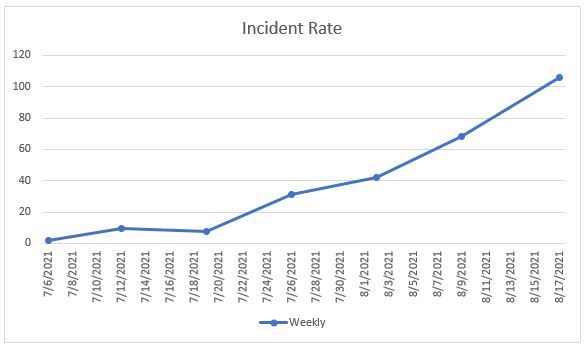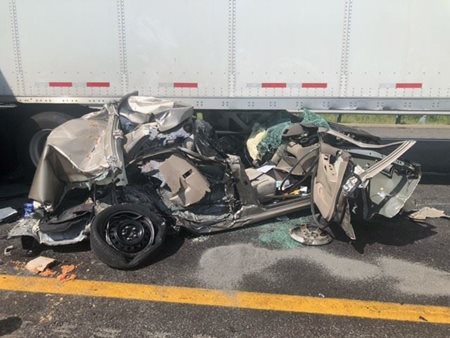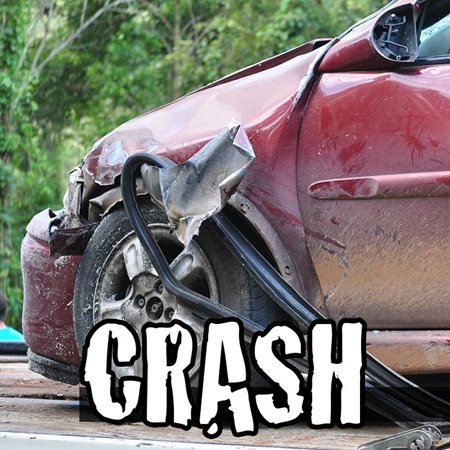The second day of hearings into the crash of the Delta Mariner into the Eggner’s Ferry Bridge began Tuesday at Paducah City Hall with a presentation of audio taken from an on board audio recorder moments before the cargo ship slammed into the bridge tearing off a 322 foot section onto the ship.
You could hear on the tape a conversation between the ship’s captain, Lloyd Patten, pilot William Collins and chief mate John Newland. When Collins realized the ship was in the wrong channel, Patten asked him if he was sure about that. Collins told Patten “yeah we can go around it.” Then moments later, the ship crashes into the bridge.
More questions about the bridge’s lighting system were brought up again as Eric Washburn, a bridge administrator with the US Coast Guard Bridge Branch Division 8, was asked a few questions regarding lighting on the bridge.
Coast Guard Lt. Jamie Salinas asked Washburn whose responsibility it was to maintain lighting on the bridge. Washburn said the owner and operator of the bridge is responsible for the lights and needed to make sure they are in working order. He also said the lights must be working 90 percent of the time, be secured in place and must been seen from a distance of 2000 yards. Ten percent of the time lights may be affected for various reasons like fog, bad weather or a outage problem.
Washburn also says if his office is notified of any problem like the lights being out, then a broadcast will be issued to mariners. He says if mariners report the problem directly to the Ohio Valley sector office in Louisville, then they will put out the broadcast. Once either party is notified that the lights are fixed, then they will informer mariners and cancel the broadcast.
Washburn did say he was informed by the Kentucky Transportation Cabinet about the lights being out on the bridge prior to the collision and that the lights had been fixed. Washburn says he did send a letter on Dec. 15 to the Transportation Cabinet highlighting its responsibilities to maintain the lights and the need to install retroreflective panels on the bridge. He did get word from transportation officials that all lights were fixed and panels ordered. Washburn also said during questioning that its not a written policy to notify bridge owners of lights being out bridges, but if his office gets a report, someone in that office will notify the owner if lights are out.
Washburn’s office also sends out a letter to bridge owners from time to time asking for updated contact information in case of emergencies.
Captain John Michael Newland, chief mate of the Delta Mariner, was questioned by the panel Tuesday afternoon. Newland, who has 32 years of experience in the maritime industry, most around deep sea service, told Coast Guard Lt. Jamie Salinas that he took watch from Captain Lloyd Patten at 3 pm on Jan. 26 and turnover was routine that day. He said visibility was reduced, but it was adequate to navigate the river.
He says as the ship approached the Eggner’s Ferry Bridge, the approach seemed routine, but it became apparent that very late in the approach that it was not and at that point, he was the helmsman in charge of steering the boat. Newland said he went to full stern, engaged the bridge, rang the general alarm, then secured the boat, lowered the anchor along with other things and started salvage activities from that point on. He also believed that there was some confusion as to where the ship was going before coming into contact with the bridge. He didn’t know if anyone had called out on the radio to ask for clarification on bridge lighting or hear the broadcast notice to mariners during his watch. He said he took action knowing the ship was not going to make it under the bridge.
Newland was also asked if the ship could be navigated on the Tennessee River with a pilot or advisor. He said no sir.
When asked who was in charge of the ship’s safety, Newland said, “With all respect we all were.” But as senior officer, Newland said he was in charge.
Newland says the ship was equipped with two sets of radars, a radar mast and another mast that can be raised and lowered to get the right height to pass under the bridges. From this, he said, a spreadsheet is developed to help them get the bridge heights before going under the bridge. He said “the system has never failed us.”
He added that the crew made it a daily practice twice a day to get information about pool height from TVA so they can adjust the ship to pass under various bridge heights on the 1300 mile river course. Newland also said those on watch would watch for things in reduced visibility to protect the ship from harm by using spotlights to locate visual lines on either side of the vessel and relay that information to the helmsman so he can move the vessel without problems. It was also pointed out by Newland that they require local pilots to give information about what is happening on the river.
He also says everyone on the ship looks at the notice to mariners that is broadcast by the Coast Guard and that it is company policy to do so. There was also a notice issued about core sampling happening on the river. Newland says he, along with two other licensed people on the bridge, was on the lookout for anything concerning this that could impede navigating the river. They didn’t see anything about core sampling on their radar that would impede their travel.
When asked if he knew if the bridge was lit correctly, he could not remember anyone discussing that. He said he was focused on centering the vessel. He could also not remember anything else that was said about the bridge due to a lot of ambient noise when the windscreen wipers were on. He also couldn’t remember if anything was mentioned about the ship being on the proper course for transit.
Newland says to his knowledge the ship went under the main span of the bridge the other 11 times it has travel on the river.
The hearing continues Wednesday at Paducah City Hall.
Advertisement
Horrific Audio From Delta Mariner Crash Heard
Advertisement
Latest Western Kentucky
Western Kentucky
Feb. 16, 2023
Western Kentucky
Aug. 18, 2021
Western Kentucky
Aug. 14, 2021
Western Kentucky
May. 27, 2021
Western Kentucky
Apr. 27, 2021
ADVERTISEMENT
Most Read >
ADVERTISEMENT
Latest Western Kentucky
Western Kentucky
Feb. 16, 2023
Western Kentucky
Aug. 18, 2021
Western Kentucky
Aug. 14, 2021
Western Kentucky
May. 27, 2021
Western Kentucky
Apr. 27, 2021
Advertisement
ADVERTISEMENT





